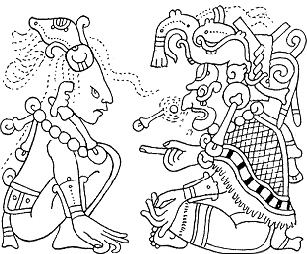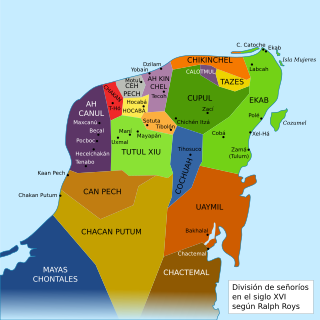
Mayapan is a Pre-Columbian Maya site a couple of kilometers south of the town of Telchaquillo in Municipality of Tecoh, approximately 40 km south-east of Mérida and 100 km west of Chichen Itza; in the state of Yucatán, Mexico. Mayapan was the political and cultural capital of the Maya in the Yucatán Peninsula during the Late Post-Classic period from the 1220s until the 1440s. Estimates of the total city population are 15,000–17,000 people, and the site has more than 4,000 structures within the city walls, and additional dwellings outside.

The Itza are a Maya ethnic group native to the Péten region of northern Guatemala and parts of Belize. The majority of Itza are inhabitants of the city of Flores on Lake Petén Itzá, and nearby portions of Belize where they form an ethnic minority.

Hunac Ceel Cauich was a Maya general from Telchaquillo who conquered Chichen Itzá and founded the Cocom dynasty. While the rulers of Chichen Itzá were in part descendants of Toltec outsiders who might have been disliked for being foreign oppressors or the war a simple one of conquest, the Maya history attributes the cause of the war to the theft of a wife of a powerful ruler by a powerful lord.

Until the discovery that Maya stelae depicted kings instead of high priests, the Maya priesthood and their preoccupations had been a main scholarly concern. In the course of the 1960s and over the following decades, however, dynastic research came to dominate interest in the subject. A concept of royal ʼshamanismʼ, chiefly propounded by Linda Schele and Freidel, came to occupy the forefront instead. Yet, Classic Maya civilization, being highly ritualistic, would have been unthinkable without a developed priesthood. Like other Pre-Hispanic Mesoamerican priesthoods, the early Maya priesthood consisted of a hierarchy of professional priests serving as intermediaries between the population and the deities. Their basic skill was the art of reading and writing. The priesthood as a whole was the keeper of knowledge concerning the deities and their cult, including calendrics, astrology, divination, and prophecy. In addition, they were experts in historiography and genealogy. Priests were usually male and could marry. Most of our knowledge concerns Yucatán in the Late Postclassic, with additional data stemming from the contemporaneous Guatemalan Highlands.

Chikinchel was the name of a Mayan chiefdom of the northern coast of Yucatán, before the arrival of the Spanish conquistadors in the sixteenth century. Chauacá has also been used to refer to this province, but apparently it was the name of the main city.

Ah Canul was the name of a Maya Kuchkabal of the northwest Yucatán Peninsula, before the arrival of the Spanish conquistadors in the 16th century.

Ah Kin Chel was the name of a Maya chiefdom or Kuchkabal of the northern Yucatán Peninsula, before the arrival of the Spanish conquistadors in the 16th century.

Can Pech was the name of a Maya chiefdom of the southwestern Yucatán Peninsula, before the arrival of the Spanish conquistadors in the sixteenth century. Can Pech was south of Ah Canul and north of Chakán Putum, on the coast of the Gulf of Mexico. In 1517, the population of its capital city was approximately 36,000, judging by the description of the city by Bernal Díaz del Castillo.

Ceh Pech is the name of a post-classic Maya ruling family and a province, or kuchkabal of the northern Yucatán Peninsula.

Chakán Putum was the name of a Mayan chiefdom of the southwestern Yucatán Peninsula, before the arrival of the Spanish conquistadors in the 16th century. Its capital city was a major Mayan port city with some 8000 buildings. The modern city of Champotón, Campeche was constructed at this location.

Cupul or Kupul was the name of a Maya chiefdom at time of the Spanish conquest of Yucatán. Cupul was one of the most extensive and densely populated Maya provinces on the Yucatán Peninsula. It was formed in the mid-fifteenth century after the fall of Mayapan and reached its maximum power during the sixteenth century, at the time of their own Spanish conquest led by the adelantado Francisco de Montejo. According to the Encyclopedia Yucatán in time, the Mayan voice ku-pul, means that throws the bouncing, giving a connotation referring to the Mayan ballplayers that existed in the region.

Ekab or Ecab was the name of a Mayan chiefdom of the northeastern Yucatán Peninsula, before the arrival of the Spanish conquistadors in the sixteenth century. In the fifteenth century most of Yucatán was controlled by the League of Mayapan. By 1441 there was civil unrest. The provinces of the League rebelled and formed sixteen smaller states. These states were called Kuchkabals. Most Kuchkabals were ruled by a Halach Uinik, but Ekab wasn't. It was divided up into several Batabil. Each Batabil was ruled over by a leader called a Batab. In Ekab the Batabs were supposed to have equal power, but the Batabs on Cozumel had much more power than the others.

Hocabá-Homún, Hokabá-Homún or Hocabá was the name of a Maya Kuchkabal of the northwestern Yucatán Peninsula, before the arrival of the Spanish conquistadors in the sixteenth century.

Tutul-Xiu, also Tutul Xiues or Mani, was the name of a Mayan chiefdom of the central Yucatán Peninsula with capital in Maní, before the arrival of the Spanish conquistadors in the sixteenth century.

The League of Mayapan was a confederation of Maya states in the Postclassic period of Mesoamerica on the Yucatan peninsula.

A kuchkabal was a system of social and political organisation common to Maya polities of the Yucatán Peninsula, in the Maya Lowlands, during the Mesoamerican Postclassic. There were somewhere between 16 and 24 such provinces just prior to the Spanish conquest of Yucatán.
Halach uinik or halach uinic was the name given to the supreme ruler, overlord or chief, as they were called in the colonial period of a Maya kuchkabal.

Ah Xiu Xupan (Maya glyphs ) was the last known ruler of the Mayan chiefdom of Tutul-Xiu when it was part of the League of Mayapan.

The Peten Itza kingdom was a kingdom centered on the island-city of Nojpetén on Lake Peten Itza.
Mo-Chel was the first Halach Uinik of the Kuchkabal Ah Kin Chel. He started the rule of the Chel family and the political state ruled by them. He was originally a nobleman, the son in law of one of the principal priests at Mayapan. Another priest Ah Xupan Nauat married his daughter Namox Chel to Mo. He is said to have foreseen the destruction of the League of Mayapan, and he fled with some followers to Tecoh near Izamal, where he established an independent state. He named the nation Ah Kin Chel.
![]()
![]() in Maya glyphs) were the ruling family of the Maya Kuchkabal of Ah Kin Chel.
in Maya glyphs) were the ruling family of the Maya Kuchkabal of Ah Kin Chel.





